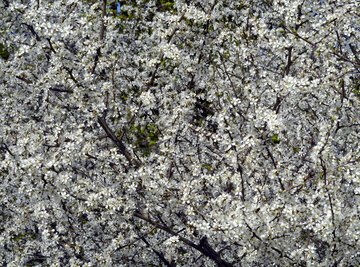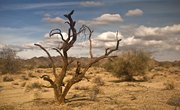
The chanticleer pear is categorized as an upright pyramidal ornamental pear tree. The tree is well known for its easy maintenance and high tolerance for cold weather. It isn't very large nor is the fruit that it bears, making it an ideal addition to your yard. Moreover, the spring and fall foliage and flowers produce stunning colors that add to a yard's vibrancy.
General Information
The chanticleer pear grows to roughly 35-feet tall and no more than 15-feet wide. As a result, it's considered a medium-small deciduous tree. The upright, pyramidal branches are strong and bear the weight of snow and ice well in winter months. According to Colorado State University the tree is adaptable to most soils, tolerates drought, heat and cold, and resists pollution. Furthermore it's highly resistant to fire blight, a deadly bacterial disease that affects many other ornamental pear trees.
Foliage and Bark
Typically, the chanticleer pear has a dark, glossy green foliage in summer months that transforms to a bright purplish red during the fall months, just before the leaves wilt. The leaves are generally 3.5 to 7.5 centimeters in size and are described as simple ovate to broad-ovate. The bark is a vivacious brown during the plant's youth and develops a gritty look as it matures. Mature trees also develop large lenticles, pores that help in the exchange of gasses from within the tree and the atmosphere.
Flowers and Fruit
In spring, usually around March, the tree produces a massive bloom of flower clusters on the tree's new growth. The flowers are roughly 2.5 centimeters in size, are a vibrant white with five petals, and have purple anthers. Flower clusters typically measure 7.5 centimeters across. The fruit are small, olive green, and look like tiny sprouting peas. The fruit appears later in summer and remains firmly attached to the tree for a few weeks before it begins to fall. Although bitter to taste for humans, birds and other wildlife love the fruit and will usually eat it all before it has a chance to make a mess of your yard.
Maintenance
The chanticleer pear can be planted and replanted at any stage of its life cycle because of its high adaptability. The tree thrives in full sunlight but will tolerate partial shade, and only needs pruning once a year in late winter or very early spring. Pruning includes removing the lowest branches to create head room for growth. Once the plant has established itself it requires little maintenance, apart from the removal of the occasional dead branch.
References
About the Author
Based in Victoria, British Columbia, Sebastian Malysa began his writing career in 2010. His work focuses on the general arts and appears on Answerbag and eHow. He has won a number of academic awards, most notably the CTV Award for best proposed documentary film. He holds a Master of Arts in contemporary disability theater from the University of Victoria.
